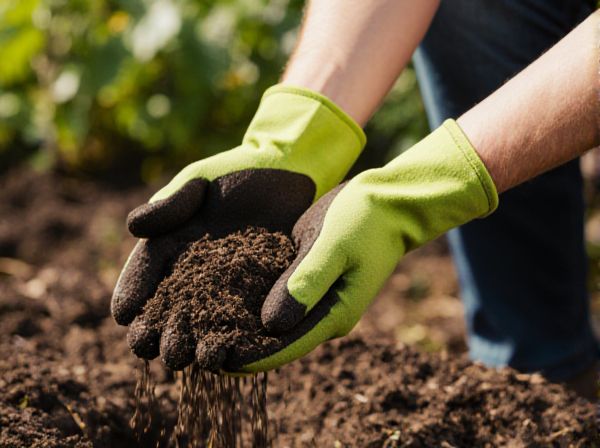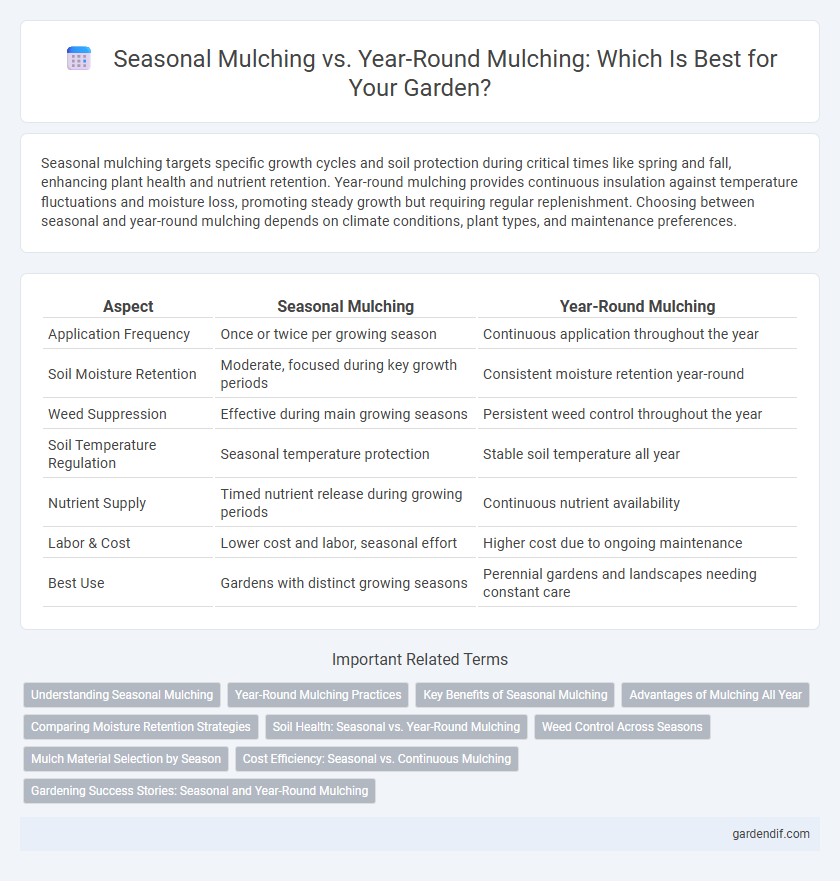
Seasonal mulching vs Year-round mulching Illustration
Seasonal mulching targets specific growth cycles and soil protection during critical times like spring and fall, enhancing plant health and nutrient retention. Year-round mulching provides continuous insulation against temperature fluctuations and moisture loss, promoting steady growth but requiring regular replenishment. Choosing between seasonal and year-round mulching depends on climate conditions, plant types, and maintenance preferences.
Table of Comparison
| Aspect | Seasonal Mulching | Year-Round Mulching |
|---|---|---|
| Application Frequency | Once or twice per growing season | Continuous application throughout the year |
| Soil Moisture Retention | Moderate, focused during key growth periods | Consistent moisture retention year-round |
| Weed Suppression | Effective during main growing seasons | Persistent weed control throughout the year |
| Soil Temperature Regulation | Seasonal temperature protection | Stable soil temperature all year |
| Nutrient Supply | Timed nutrient release during growing periods | Continuous nutrient availability |
| Labor & Cost | Lower cost and labor, seasonal effort | Higher cost due to ongoing maintenance |
| Best Use | Gardens with distinct growing seasons | Perennial gardens and landscapes needing constant care |
Understanding Seasonal Mulching
Seasonal mulching involves applying mulch during specific times of the year to optimize soil temperature, moisture retention, and plant health. This method targets critical growth periods such as spring and fall, enhancing nutrient availability and weed suppression when plants are most active. Understanding seasonal mulching helps gardeners tailor their mulch application to seasonal climate changes and plant lifecycle needs, promoting sustainable garden management.
Year-Round Mulching Practices
Year-round mulching practices maintain consistent soil moisture, regulate temperature, and suppress weeds throughout all seasons, promoting healthier plant growth and improved soil structure. Organic mulches like shredded bark, compost, and straw decompose gradually, enriching soil nutrients while protecting roots from extreme weather conditions. Continuous mulch application reduces erosion and conserves water, making it a sustainable and efficient gardening technique across various climates.
Key Benefits of Seasonal Mulching
Seasonal mulching improves soil moisture retention, regulates temperature fluctuations, and enhances nutrient availability during critical growing periods, promoting healthier plants. It also reduces weed growth and soil erosion more effectively by aligning mulch application with plant life cycles. This targeted approach maximizes resource efficiency while supporting sustainable garden management throughout changing seasons.
Advantages of Mulching All Year
Mulching all year enhances soil moisture retention, stabilizes temperature fluctuations, and suppresses weeds throughout every season, leading to healthier plant growth. Continuous mulch coverage enriches soil organic matter by promoting microbial activity and reducing erosion consistently. Year-round mulching also minimizes maintenance efforts and protects root systems from extreme weather conditions, ensuring sustainable garden productivity.
Comparing Moisture Retention Strategies
Seasonal mulching targets specific periods to enhance soil moisture retention by applying organic materials like straw or wood chips during dry or dormant seasons, reducing evaporation and conserving water. Year-round mulching maintains a consistent protective layer that continuously moderates soil temperature, reduces weed growth, and sustains moisture levels, promoting stable plant health throughout all seasons. Comparing these strategies reveals that seasonal mulching offers focused moisture conservation during critical growth phases, while year-round mulching provides ongoing soil protection and hydration balance.
Soil Health: Seasonal vs. Year-Round Mulching
Seasonal mulching targets specific growth periods, enhancing soil moisture retention and nutrient release primarily during active plant cycles. Year-round mulching maintains consistent soil temperature, prevents erosion, and fosters continuous microbial activity, promoting sustained soil fertility. Research shows that year-round mulching significantly improves organic matter content and soil structure stability compared to seasonal applications.
Weed Control Across Seasons
Seasonal mulching targets weed control by applying mulch during peak growing periods, effectively suppressing weed germination and growth when they thrive the most. Year-round mulching provides continuous coverage, reducing weed emergence across all seasons by maintaining consistent soil moisture and temperature regulation. Both methods improve soil health, but year-round mulching offers sustained weed suppression benefits through varying climatic conditions.
Mulch Material Selection by Season
Selecting the appropriate mulch material for each season enhances soil health and plant growth by aligning with environmental conditions and plant needs. In spring and summer, organic mulches like shredded bark or straw help retain moisture and regulate soil temperature, while in fall and winter, heavier mulches such as hardwood chips or pine needles provide insulation against frost and reduce soil erosion. Tailoring mulch material by season improves nutrient cycling and supports sustainable garden management throughout the year.
Cost Efficiency: Seasonal vs. Continuous Mulching
Seasonal mulching reduces material and labor costs by applying mulch only during peak growth periods, optimizing resource use without excess expenditure. Year-round mulching incurs higher upfront and maintenance costs due to frequent replenishment and potential waste, but it offers consistent soil protection and moisture retention. Cost efficiency depends on local climate, crop type, and the balance between initial investment and long-term soil health benefits.
Gardening Success Stories: Seasonal and Year-Round Mulching
Seasonal mulching optimizes soil moisture and temperature during specific growth phases, promoting healthy root development and reducing weed competition in spring and fall. Year-round mulching consistently maintains soil structure and nutrient levels, enhancing long-term plant resilience and minimizing water evaporation in various climates. Gardeners report increased crop yields and vibrant foliage by tailoring mulching practices to plant needs and seasonal conditions.
Seasonal mulching vs Year-round mulching Infographic

 gardendif.com
gardendif.com